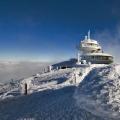Memorable events on April 12. "The most exciting day
In 1861, on April 12, the civil war between North and South began in the United States with the bombing of federally owned Fort Sumter at the entrance to the port of Charleston in South Carolina by southerners.
The reasons for the military conflict are simple: the industrialized North needed free skilled labor, while the labor of black slaves flourished in the agricultural South. At the same time, many northerners were convinced of the inhumanity of slavery and sincerely desired the liberation of slaves. The situation worsened after the election of Abraham Lincoln, a supporter of the abolition of slavery, to the presidency of the United States. Seven southern states seceded from the union, formed the Confederacy, and formed a provisional government, electing Jefferson Davis as president. The Confederate Constitution confirmed the legality of slavery. Civil War ended 4 years later with the victory of the northerners.
The history of those years haunted the modest Atlanta housewife Margaret Mitchell, and in 1936 she wrote her only novel, Gone with the Wind, which made her famous and became a world bestseller.
In 1903, England's first urban omnibus line, operated by mechanically-powered multi-seat carriages, opened in Eastbourne.
The word "omnibus" is Latin for "for all." Horse-drawn omnibuses first appeared in Paris in 1662 at the suggestion of the great mathematician and philosopher Blaise Pascal “for persons who do not have the opportunity to use a carriage.” However, after some time, the Parisian authorities banned “people of low rank” - workers, soldiers, servants - from traveling in omnibuses. Thus, the new type of transport lost its main contingent and ceased to exist for a long time, reviving only in the first third of the 19th century.
In 1918, the Council of People's Commissars issued a decree on the monuments of the republic.
“In commemoration of the great revolution that transformed Russia,” it said, “the Council People's Commissars Decrees: monuments erected in honor of kings and their servants and not of interest from either a historical or artistic point of view are subject to removal from squares and streets and partly transferred to warehouses, partly used for utilitarian purposes.”
Another point of the decree prescribed: “to mobilize artistic forces and organize a broad competition to develop designs for monuments to commemorate the great days of the Russian Socialist Revolution.”
In 1919, the first communist subbotnik was held in Moscow.
On this day, which fell on a “day off,” workers at the Moscow-Sortirovochnaya depot repaired 3 locomotives free of charge. The initiative, which Vladimir Ilyich called great, at the request of the party was taken up by the whole country, and a new word “subbotnik” appeared in the dictionary - unpaid work for the good of the country.
In 1961, USSR citizen Yuri Alekseevich Gagarin spaceship“Vostok” made an orbital flight around the Earth for the first time in the world, opening the era of manned space flights.
The flight lasted 108 minutes. The ship landed southwest of the city of Engels on the field of the Leninsky Put collective farm. By order of the USSR Minister of Defense No. 77, for the successful completion of a government assignment, the first cosmonaut of the Earth, Senior Lieutenant Gagarin, was awarded the extraordinary rank of major. On April 14, Moscow solemnly welcomed the hero.
Ah, this day is the twelfth of April,
How he swept through people's hearts.
It seemed as if the world had involuntarily become kinder,
Shocked by his victory,
- wrote Alexander Tvardovsky.
Before Gagarin, 5 test launches were made. They showed that space does not forgive the slightest inaccuracy: the first ship, having completed the program, did not obey the command to descend, went into orbit and subsequently ceased to exist. The second launch was successful. But at the end of 1960, on the third launch of the Vostok-class spacecraft, there was another failure: the device burned out during return.
Gagarin took a risk that could cost his life.
According to the decision of the International Aeronautical Federation, April 12 is celebrated as International Aviation and Cosmonautics Day.
On April 12, 1961, at 9:07 am Moscow time, the Vostok-1 spacecraft launched from the Baikonur Cosmodrome in Kazakhstan, carrying cosmonaut Yuri Gagarin. For the first time in history spacecraft with a person on board, went into outer space, flying in the orbit of an artificial Earth satellite.
Everyone knows Gagarin’s famous word “Let’s go!”, which he exclaimed during the start. And few people know the exclamation of Chief Designer Sergei Korolev. As he watched the launch vehicle go up, Korolev said: “If only he could fly off and come back alive!” All participants in this feat made incredible efforts to ensure that this was the case, but there was no absolute confidence in a successful outcome. Therefore, the incredible tension that reigned in the control center lasted all 108 minutes of this epoch-making flight.
The satellite ship from the Vostok series, on which Gagarin made his first flight into space, deserves special attention. The device itself is launched by a multi-stage launch vehicle, from which it must separate after reaching the desired height. The ship consisted of two parts: a cabin in which life support systems and a control panel were located, and a second compartment with a braking engine and other instruments.
In the cockpit there is a chair in which a catapult is built, separating it from the ship. In addition, the chair is equipped with a supply of food and medicine, a walkie-talkie and even a rescue boat in case of a forced landing on the water. As you know, the shell of a ship located in dense layers of the atmosphere heats up to an incredible temperature, so a special thermal protection system for the hull was provided, and the windows were made of heat-resistant glass. We can say that the means of delivering the first cosmonaut into orbit was absolutely technologically revolutionary for its time. And the issue of his safe return was thought out to the smallest detail.
In total, there were exactly twenty candidates for the first flight into space - all military pilots who were selected for specific characteristics. The Queen needed a man under 30 years of age, weighing 72 kg and height 170 cm, with good physical and mental health. The cabin of the Vostok-1 ship was designed in such a way that a person with certain physical characteristics could fit in it. At first, out of twenty candidates, six were selected, and the final decision was made almost at the last moment. It was decided to send Yuri Gagarin first on the flight, and German Titov was to become his backup.
On April 12, 1961, at the beginning of ten o'clock in the morning, the command “Start!” was given, and for the first time a spaceship with a person on board, propelled by a launch vehicle, set off from the Baikonur Cosmodrome into earth orbit. Gagarin did not have a special program; his task was to fly into orbit and return alive. And yet, during the flight, he experimented a little: he tried to eat and drink, write notes with a pencil, while in a state of weightlessness. The ship's flight lasted only 108 minutes, during which it managed to make one revolution around our planet.
During landing, an emergency situation arose - due to problems in the braking system, the ship deviated somewhat from the planned course. However, the cosmonaut coped with the situation - by controlling the parachute lines, he made a successful landing, avoiding falling into the Volga. At 10:55 a.m., the descent module landed on soft arable land near the Volga bank near the village of Smelovka, Ternovsky district, Saratov region. The first human flight into space has successfully completed.
1242 - Battle on the Ice(Battle of Lake Peipsi). A battle took place between the Novgorodians and Vladimirites under the leadership of Alexander Nevsky against the knights of the Livonian Order.
1710 - F. Orlik signed the “Charter of the Zaporozhian Army” in the city of Bendery.
1806 - The Spaniards stopped boycotting food supplies to Russian settlements in Alaska.
1812 - Russia and Sweden entered into an agreement on joint actions against France.
1814 - After the generals refused to lead the army to Paris, occupied by the troops of the allies - Russia, Prussia, Austria and Great Britain, the French Emperor Napoleon I abdicated the throne, but the abdication was not accepted by the allied command.
1899 - The first edition of V.I.’s first book was published. Lenin "The Development of Capitalism in Russia".
1905 - Composer N.A. Rimsky-Korsakov refused in print the title of honorary member of the Russian Musical Society (RMS).
1918 - Landing of Japanese troops in Vladivostok.
1921 - In Constantinople, Baron P.N. Wrangel formed the “Russian Council”, which declared itself the government of Russia in exile.
1925 - L.M. Kaganovich was elected first secretary of the Central Committee of the Communist Party of Ukraine.
1931 - A team of molders from the Kharkov plant “Sickle and Hammer” signed the first self-supporting agreement in Ukraine.
1941 - Signing of the Treaty of Friendship and Non-Aggression between the USSR and Yugoslavia.
1943 - The French squadron “Normandie” (later “Normandie-Niemen”) began to operate as part of the Red Army.
1945 - Soviet Union announced the denunciation of the Non-Aggression Pact with Japan of April 13, 1941.
1945 - The Georgian uprising on the island of Texel began: the uprising of a battalion of prisoners of war of Soviet soldiers from Georgia on the Dutch island of Texel against the German occupiers during World War II.
1963 - The automatic station Luna-4E (launched on April 2 from the Baikonur Cosmodrome), due to a deviation of the flight trajectory from the calculated one, passed at a distance of 8,500 kilometers from the surface of the Moon and was lost in space. It was assumed that the spacecraft would make a soft landing on the lunar surface.
1970 - By decision of the leadership of the USSR, the remains of A. Hitler and E. Braun were exhumed and destroyed 11 km from Magdeburg by cremation.
1978 - Deputy Secretary General of the UN and Ambassador Extraordinary and Plenipotentiary of the USSR to the UN A.N. Shevchenko asked for political asylum in the United States.
1980 - The USSR and Afghanistan signed an agreement on the presence of a contingent of Soviet troops in Afghanistan.
1982 - During a military operation in western Afghanistan Soviet troops mistakenly invaded Iran.
1988 - The Pravda newspaper published an article “Principles of Perestroika” criticizing N.A.’s article. Andreeva “I can’t compromise on principles.”
1991 - The Supreme Council of the RSFSR provided B.N. Yeltsin has emergency powers.
1991 - One of the famous aviation aerobatic teams “Russian Knights” was formed in Kubinka.
1992 - Vice President of Russia A.V. Rutskoi supported the independence of Transnistria during his visit to Tiraspol.
1993 - Establishment of the oil company Lukoil by decree of the Government of the Russian Federation.
2005 - A.A. Akaev resigned as president of Kyrgyzstan.
By decree of the English King James I, who was also King James VI of Scotland, a new flag was introduced, which later became known as the “Union Jack”. Since England and Scotland were then independent states, the flag was used as an additional flag on the ships of both countries to show that they serve the same sovereign
The British fleet under the command of Admiral Rodney defeats the French fleet at the Holy Battle of the West Indies.
A decree was issued “On the establishment of the Alexander Hospital in St. Petersburg for the working population in memory of February 19, 1861.”
Announcement Highest resolution emperor Alexandra III free entry and exit from Russia
The world's first city bus powered by an internal combustion engine has launched in London.
The first non-stop flight from London to Paris is carried out by the chief pilot instructor of the Bleriot Flight School in Hendon, Pierre PRIER, in a Bleriot monoplane with a 50 hp Gnome engine. It takes off from Hendon airfield (UK) and lands at Issy-les-Moulineaux airfield (France) 3 hours 56 minutes later.
The first All-Russian Aeronautical Congress took place in St. Petersburg. Among its participants were: Minister of the Navy Vice Admiral I. N. Grigorovich, Lieutenant S. F. Dorozhinsky, member of the Naval Technical Committee Major General N. G. Korsakevich, Admiral M. A. Rykachev, Captain 2nd Rank A. A. Yanovich and a number of other naval officers
On the evening of April 11, preparations began in Moscow to get rid of the anarchist gangs that were terrorizing the city. At 3 o'clock in the morning on April 12, a raid was carried out on 26 anarchist nests at once. The operation was crowned with complete success: the anarchists were driven out of all the houses they had captured, having lost all their weapons and loot.
First Communist subbotnik (3 locomotives were repaired at the Moscow-Sortirovochnaya station)
Wind speed of 372 kilometers per hour was recorded on Mount Washington (New Hampshire, USA)
On the 40th anniversary of the first Communist subbotnik, the Ov-7024 steam locomotive was installed on the territory of the Moscow-Sortirovochnaya locomotive depot - one of three steam locomotives repaired at that time
The world's first human flight into space, carried out by Yuri Gagarin on the Soviet spaceship Vostok
Rio de Janeiro, Brazil. VASP's NAMC YS-11A-211 crashes on approach. All 25 people on board die
Florianopolis, Brazil. Ytsmdntsdo's Boeing 727-27 crashes into a hill while landing in a thunderstorm. 55 of the 58 people on board die. The pilot did not estimate the speed and distance and did not have time to make a new circle. Disadvantages of piloting
Cosmonautics Day is a memorable date celebrated on April 12, established to commemorate the first manned flight into space.
History and celebration
On April 12, 1961, Soviet cosmonaut Yu. A. Gagarin launched from the Baikonur cosmodrome on the Vostok spacecraft and for the first time in the world made an orbital flight around the planet Earth. The flight in near-Earth space lasted 108 minutes.
In the Soviet Union, the holiday was established by the Decree of the Presidium of the Supreme Soviet of the USSR dated April 9, 1962. Celebrated as Cosmonautics Day. This holiday was established at the suggestion of the second Pilot-Cosmonaut of the USSR, German Titov, who addressed the CPSU Central Committee with a corresponding proposal on March 26, 1962.
On the same day, World Aviation and Cosmonautics Day is celebrated in accordance with the protocol (clause 17) of the 61st General Conference of the Fédération Aéronautique Internationale, held in November 1968 and the decision of the Council of the Fédération Aéronautique Internationale, adopted on April 30, 1969, on the proposal of the Air Sports Federation THE USSR.
IN Russian Federation Cosmonautics Day is celebrated in accordance with Article 1.1 Federal Law dated March 13, 1995 No. 32-FZ “On the days military glory and memorable dates in Russia."
International Day of Human Space Flight

On April 7, 2011, at a special plenary meeting of the UN General Assembly, a resolution was adopted that officially proclaimed April 12 as the International Day of Human Space Flight. More than 60 states co-sponsored the resolution.
Other events of this day
Exactly twenty years after the first manned flight into space, on April 12, 1981, the first manned flight of the American Space Shuttle program took off.
In honor of both these events, the “St. George’s Night” party-event has been held in many cities around the world since 2001. The organizer is the Space Generation Advisory Council, a non-governmental organization that brings together participants from more than 60 countries.
Links
Yuriev's night (http://ru.wikipedia.org/wiki/Yuriev_noch_(cosmonautics));
Space Forces Day (http://ru.wikipedia.org/wiki/Space_Forces_Day);
Gagarin, Yuri Alekseevich (http://ru.wikipedia.org/wiki/Gagarin,_Yuri_Alekseevich);
Sputnik-1 (http://ru.wikipedia.org/wiki/Sputnik-1);
 How to help your child remember the spelling of vocabulary words Why learn vocabulary words
How to help your child remember the spelling of vocabulary words Why learn vocabulary words Methods of geography Methods and technologies of research in geographical sciences
Methods of geography Methods and technologies of research in geographical sciences Family and everyday play “Marriage” Characters in the play “Marriage”
Family and everyday play “Marriage” Characters in the play “Marriage”